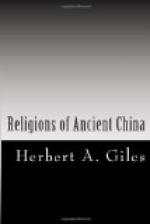From Buddhism the Taoists borrowed their whole scheme of temples, priests, nuns, and ritual. They drew up liturgies to resemble the Buddhist Sutras, and also prayers for the dead. They adopted the idea of a Trinity, consisting of Lao Tzu, P’an Ku, and the Ruler of the Universe; and they further appropriated the Buddhist Purgatory with all its frightful terrors and tortures after death.
Nowadays it takes an expert to distinguish between the temples and priests of the two religions, and members of both hierarchies are often simultaneously summoned by persons needing religious consolation or ceremonial of any kind.
Doubts.—In a chapter on “Doubts,” by the Taoist philosopher Mou Tzu, we read,
“Some one said to Mou, The Buddhist doctrine teaches that when men die they are born again. I cannot believe this.
“When a man is at the point of death, replied Mou, his family mount upon the house-top and call to him to stay. If he is already dead, to whom do they call?
“They call his soul, said the other.
“If the soul comes back, the man lives, answered Mou; but if it does not, whither does it go?
“It becomes a disembodied spirit, was the reply.
“Precisely so, said Mou. The soul is imperishable; only the body decays, just as the stalks of corn perish, while the grain continues for ever and ever. Did not Lao Tzu say, ’The reason why I suffer so much is because I have a body’?
“But all men die whether they have found the truth or not, urged the questioner; what then is the difference between them?
“That, replied Mou, is like considering your reward before you have put in right conduct for a single day. If a man has found the truth, even though he dies, his spirit will go to heaven; if he has led an evil life his spirit will suffer everlastingly. A fool knows when a thing is done, but a wise man knows beforehand. To have found the truth and not to have found it are as unlike as gold and leather; good and evil, as black and white. How then can you ask what is the difference?”
Buddhism, which forbids the slaughter of any living creature, has wisely abstained from denouncing the sacrifice of victims at the Temple of Heaven and at the Confucian Temple. But backed by Confucianism it denounces the slaughter for food of the ox which tills the soil. Some lines of doggerel to this effect, based upon the Buddhist doctrine of the transmigration of souls and put into the mouth of an ox, have been rendered as follows:—
My murderers shall come
to grief,
Along with all who relish
beef;
When I’m a man
and you’re a cow,
I’ll eat you as
you eat me now.
Fire Worshippers.—Mazdeism, the religion of Zoroaster, based upon the worship of fire, and in that sense not altogether unfamiliar to the Chinese, reached China some time in the seventh century A.D. The first temple was built at Ch’ang-an, the capital, in 621, ten years after which came the famous missionary, Ho Lu the Magus. But the lease of life enjoyed by this religion was of short duration.




